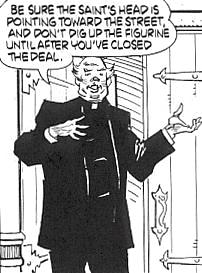Claim: Burying a statuette of St. Joseph on the property will help speed the sale of a home.
 | LEGEND |
Example: [Cohen, 1997]
Many realtors have their "Believe It or Not" stories.
Such was the case of a woman who moved from Maryland to Arizona.
After eight months of paying the mortgage on her unsold home in Baltimore, she sent her agent a statue and burial instructions.
Within two weeks, the house sold.
Another case involved a couple moving because of a new job. But their house, which was in a very active neighborhood, wasn't doing anything, even with
In 1995, Betsy Moyer was determined to sell her house on Lake Avenue in Baltimore at a premium. She listed it for $15,000 more than other sellers in the same neighborhood. After seven quiet months a friend recommended that Moyer plant
The next week a group of nuns arrived to look at the house. Three months later, the house was sold at the highest price ever in that area, according to her agent.
Origins: Those trying to sell a home often feel in need of a miracle when a quick sale fails to materialize. Folklore purports to have the remedy: Bury a plastic statue of
The reputed origins of the practice vary. Some say an order of European nuns in the Middle Ages buried a medal of

the saint to intercede in its quest for a convent. Others claim it may be connected to a practice of German carpenters who buried the statues in the foundations of houses they built and said a prayer to
But these theories may well be instances of retrofitting lore to a custom because mentions older than contemporary times have failed to materialize in standard folklore references. That the custom now has an interesting backstory does not mean its backstory is valid or even that old.
The practice of burying a plastic
But why Joseph, you ask? Why not another saint — say,
Joseph, Jesus' earthly father, is the patron saint of home and family in the Roman Catholic religion. According to one of the hottest new customs, the statues are buried upside down and facing the road in front of a house for sale.1
Actually, different realtors quote different placements of the statue:
- Upside down, near the 'For Sale' sign in the front yard. (An upside down
St. Joseph is said to work extra hard to get out of the ground and onto someone's mantel.) - Right side up.
- In the rear yard, possibly in a flower bed.
- Lying on its back and pointing towards the house "like an arrow."
- Three feet from the rear of the house.
- Facing the house.
- Facing away from the house. (One who tried this reported the house across the street sold, and it hadn't even been up for sale.)
- Exactly 12 inches deep.
The custom of burying St. Joseph has become so widespread that some retailers even offer a
Prudent realtors also recommend the following advice in addition to burying Joe: "For this practice to be fully effective, the seller must, of course, first do such
practical yet all important chores as completing all necessary
Many who have experienced difficulty selling their homes have reported seemingly miraculous sales shortly after burying a statue of
Barbara "joe work" Mikkelson
Last updated: 11 June 2011
Sources: |
Atlas, Terry. "Housing Dilemma: Can't Buy or Sell." The Chicago Tribune. 28 October 1979 (p. 1). 1. Beard, Betty. "Answer to Special Prayers." The Arizona Republic. 16 May 1998 (p. EV1). Binz, Stephen. Saint Joseph, My Real Estate Agent. Ann Arbor, MI: Servant Publications, 2003. ISBN
1-569-55361-0.Brunvand, Jan Harold. The Baby Train. New York: W. W. Norton, 1993. ISBN 0-393-31208-9 (p. 181-184). Brunvand, Jan Harold. Too Good To Be True. New York: W. W. Norton, 1999. ISBN 0-393-04734-2 (pp. 246-247). Cohen, Charles. "And He Does It All Upside Down." The [Baltimore] Sun. 30 March 1997 (p. M1). Galletta, Jan. "Believing that Faith Not Only Moves Mountains . . ." Chattanooga Times. 8 April 2000 (p. E1). Ivey, James. "Gregory With Statue of St. Joseph." Omaha World-Herald. 9 December 1984. Shea, Jim. "Home Sellers Tap a Saint as Dealmaker." The Washington Post. 16 August 1997 (p. E5). Vigue, Doreen Iudica. "St. Joseph Sells." The Boston Globe. 7 December 2003. Chicago Sun-Times. "A New Compass Aims to Please." 14 January 1986 (p. 71). Los Angeles Times. "Desperate Sellers Dig That Saint." 25 November 1990 (p. K1). Omaha World-Herald. "Priest Doesn't Buy Story . . ." 21 November 1985 (p. K1). The Big Book of Urban Legends. New York: Paradox Press, 1994. ISBN 1-56389-165-4 (p. 193).
